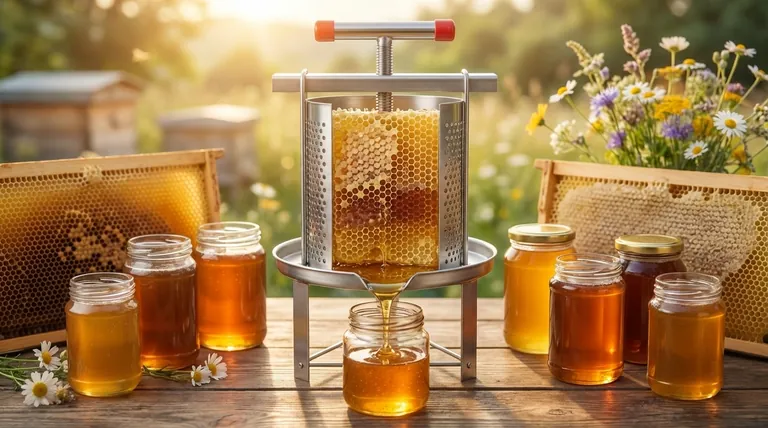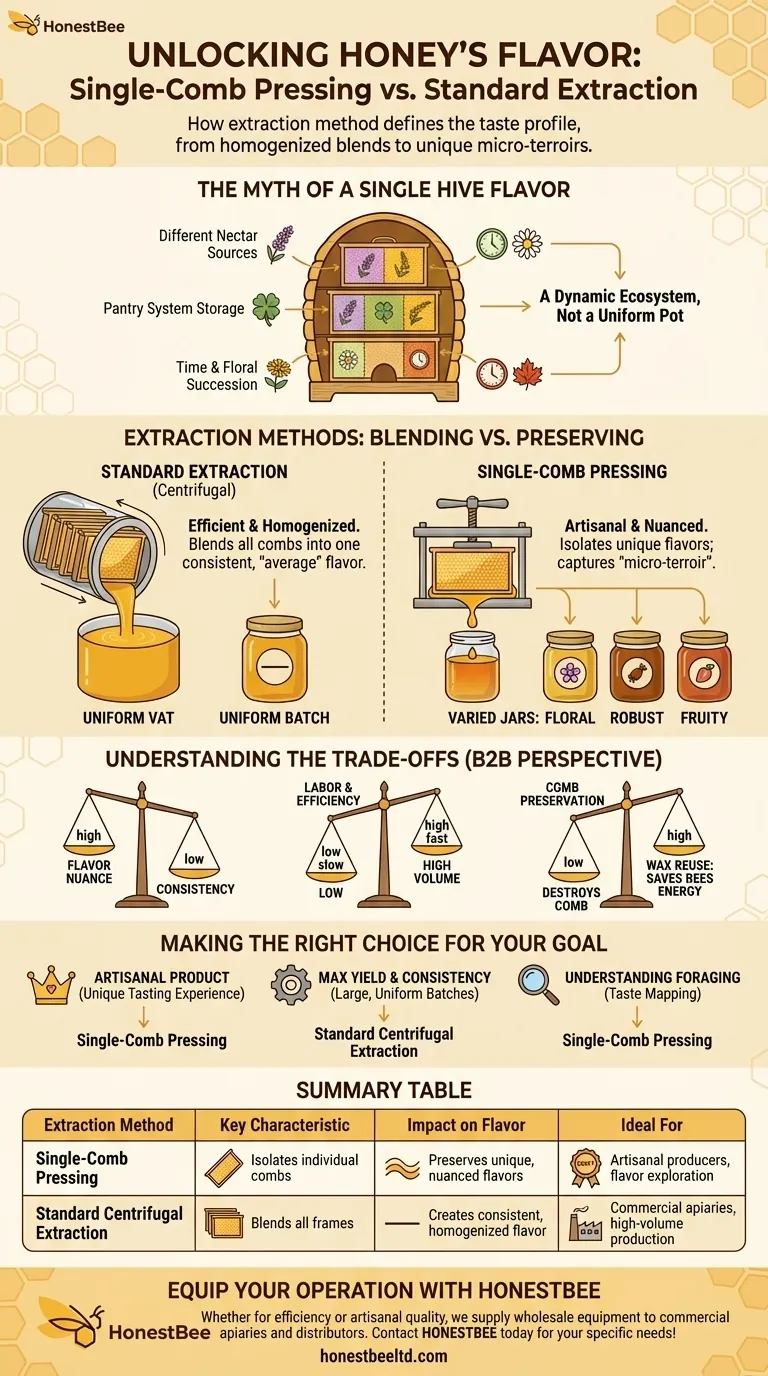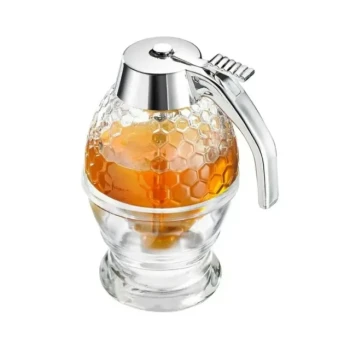In short, pressing one comb at a time isolates the unique "micro-terroir" of that specific part of the hive. This artisanal method allows you to capture and taste distinct flavor variations from different nectar sources collected at different times. These subtle nuances are completely lost in standard extraction methods where honey from all combs is blended into a single, homogenized batch.
The common practice of extracting all honey from a hive at once averages out its flavor, creating a single, uniform taste. Pressing individual combs is a deliberate technique to preserve this natural diversity, revealing a complex tapestry of flavors that tells the story of the bees' foraging journey.

The Myth of a Single Hive Flavor
Many assume that honey from one hive has one consistent taste. The reality is far more complex. A single hive is a dynamic ecosystem producing a wide variety of honey, stored in different locations within the hive itself.
A Hive Collects from Many Nectar Sources
Bees are pragmatic foragers. Even in a field of clover, they will visit other nearby wildflowers, trees, and plants. One group of foragers might focus on a patch of lavender while another discovers a blossoming linden tree a short distance away. These different nectar sources have fundamentally different sugar compositions and aromatic compounds, leading to distinct flavors.
The "Pantry" System of Honey Storage
Bees don't mix all the nectar they collect into one big pot. They store it cell by cell, often working in one section of a comb before moving to another. Honey made on Tuesday from a fruit blossom might be stored directly adjacent to honey made on Thursday from a dandelion. This creates pockets of unique honey throughout the hive, much like a pantry stocked with different types of jam.
Time and Floral Succession
The landscape changes throughout the season, and so does the honey. Early spring honey from fruit trees will be light and floral, while late summer honey from goldenrod or buckwheat will be dark and robust. Since different combs are filled, capped, and finished at different times, they are like time capsules for what was blooming during a specific week or month.
Extraction Methods: Blending vs. Preserving
The method used to remove honey from the comb is the single biggest factor in whether these unique flavors are blended away or preserved.
Standard Extraction (Centrifugal)
The most common method for honey harvesting involves a centrifugal extractor. Multiple frames are placed in a large drum, which spins at high speed. The force flings the honey out of the cells, where it all collects and mixes at the bottom. This process is highly efficient but results in a homogenized product—an "average" flavor of the entire hive for that season.
Pressing or "Crush and Strain"
Pressing is a more traditional and laborious method. A beekeeper takes a single comb, cuts or crushes it to break open the wax cells, and then presses it or allows it to drain through a filter. By keeping the yield from each comb separate, you isolate its specific contents. Each bottle becomes a unique snapshot of what the bees stored in that particular comb.
Understanding the Trade-offs
Choosing to press individual combs is a decision that prioritizes flavor nuance over efficiency. It's critical to understand the compromises involved.
Flavor Nuance vs. Consistency
Single-comb pressing delivers an unparalleled range of distinct flavors, which is a key selling point for artisanal honey. However, it sacrifices the consistency that large-scale producers and many consumers expect. The flavor of one jar can be completely different from the next, even if it came from the same hive.
Labor and Efficiency
Pressing individual combs is slow, messy, and requires significant manual labor. Centrifugal extraction is exponentially faster and is the only practical method for commercial-scale apiaries. For a hobbyist, pressing can be a rewarding process; for a business, it is a significant operational cost.
Comb and Wax Management
Pressing requires destroying the wax comb. Bees expend a tremendous amount of energy and resources (consuming about 8 pounds of honey to produce 1 pound of wax) to build these intricate structures. In contrast, centrifugal extraction leaves the comb intact, allowing it to be returned to the hive for reuse, which saves the bees significant work and boosts the next season's honey production.
Making the Right Choice for Your Goal
Your approach to extraction should align directly with what you want to achieve with your honey.
- If your primary focus is creating a unique, artisanal product: Single-comb pressing is the ideal method to showcase the subtle terroir of your apiary and offer a truly unique tasting experience.
- If your primary focus is maximizing yield and efficiency for a consistent product: Standard centrifugal extraction is the proven, industry-standard choice for producing larger, uniform batches of honey.
- If your primary focus is simply understanding your bees' foraging habits: Pressing a few individual combs can provide a fascinating "taste map" of what your bees collected throughout the season.
By understanding how honey is stored and extracted, you gain the power to decide whether to create a consistent blend or to celebrate the unique story of each individual comb.
Summary Table:
| Extraction Method | Key Characteristic | Impact on Flavor | Ideal For |
|---|---|---|---|
| Single-Comb Pressing | Isolates honey from individual combs | Preserves unique, nuanced flavors; each jar is a snapshot | Artisanal producers, flavor exploration |
| Standard Centrifugal Extraction | Blends honey from all frames in a hive | Creates a consistent, homogenized 'average' flavor | Commercial apiaries, high-volume production |
Ready to Choose the Right Extraction Method for Your Apiary?
Whether you're a commercial apiary aiming for maximum efficiency or a distributor seeking unique, artisanal products for your customers, the right equipment is key. HONESTBEE supplies beekeeping supplies and equipment to commercial apiaries and beekeeping equipment distributors through wholesale-focused operations.
Let us help you equip your operation for success. Contact HONESTBEE today to discuss your specific needs!
Visual Guide

Related Products
- Easy Use Manual Stainless Steel Honey Press for Honey Comb
- Electric Honey Press Machine for Squeezing Honey Comb Press Equipment
- Stainless Steel Manual Honey Press with Guard for Pressing Honey and Wax
- 10L Stainless Steel Electric Honey Press Machine
- Stainless Steel Honey Press Wax Press with Tank
People Also Ask
- What are the steps to operate a bucket honey press? Maximize Your Honey Yield with Simple Mechanical Force
- How does a honey press work? A Guide to Simple, High-Yield Honey Extraction
- What are the recommended conditions for using a honey press? Achieve Optimal Honey Extraction
- What is the purpose of a honey press? Maximize Yield for Small-Scale Beekeeping
- What is a honey press and how does it work? A Guide to Crush-and-Strain Extraction



















